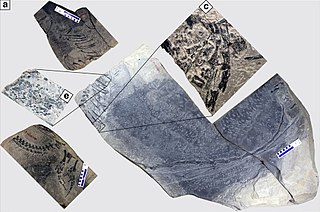
Dinocephalosaurus is a genus of long necked, aquatic protorosaur that inhabited the Triassic seas of China. The genus contains the type and only known species, D. orientalis, which was named by Li in 2003. Unlike other long-necked protorosaurs, Dinocephalosaurus convergently evolved a long neck not through elongation of individual cervical vertebrae, but through the addition of cervical vertebrae that each have a moderate length. Like other tanystropheids, however, Dinocephalosaurus probably used its long neck to hunt for prey, utilizing a combination of suction, created by the expansion of the throat, and the fang-like teeth of the jaws to ensnare prey. It was probably a marine animal by necessity, as suggested by the poorly-ossified and paddle-like limbs which would have prevented it from going ashore.
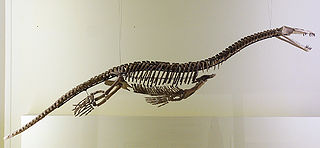
Nothosaurus is an extinct genus of sauropterygian reptile from the Triassic period, approximately 240–210 million years ago, with fossils being distributed from North Africa and Europe to China. It is the best known member of the nothosaur order.
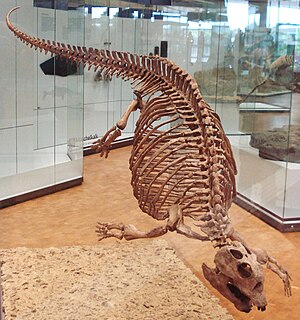
Placodonts are an extinct order of marine reptiles that lived during the Triassic period, becoming extinct at the end of the period. They were part of Sauropterygia, the group that includes plesiosaurs. Placodonts were generally between 1 to 2 m in length, with some of the largest measuring 3 m (9.8 ft) long.
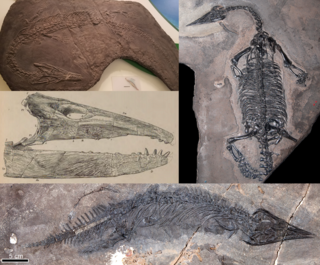
Thalattosauria is an extinct order of prehistoric marine reptiles that lived in the middle to late Triassic period. Thalattosaurs were diverse in size and shape, and are divided into two superfamilies: Askeptosauroidea and Thalattosauroidea. Askeptosauroids were endemic to the Tethys Ocean, their fossils have been found in Europe and China, and they were likely semiaquatic fish eaters with straight snouts and decent terrestrial abilities. Thalattosauroids were more specialized for aquatic life and most had unusual downturned snouts and crushing dentition. Thalattosauroids lived along the coasts of both Panthalassa and the Tethys Ocean, and were most diverse in China and western North America. The largest species of thalattosaurs grew to over 4 meters (13 feet) in length, including a long, flattened tail utilized in underwater propulsion. Although thalattosaurs bore a superficial resemblance to lizards, their exact relationships are unresolved. They are widely accepted as diapsids, but experts have variously placed them on the reptile family tree among Lepidosauromorpha, Archosauromorpha, ichthyosaurs, and/or other marine reptiles.

Miodentosaurus is a genus of thalattosaurian from the Late Triassic of China. It is one of several thalattosaurs found in the Xiaowa Formation, also known as the Wayao Member of the Falang Formation. The genus name "Miodentosaurus" translates to "Few toothed-lizard" while the species name "brevis" means "short", in reference to its short snout.

Thalattosaurus meaning "sea lizard," from the Attic Greek thalatta (θάλαττα), "sea," and sauros (σαῦρος), "lizard," is an extinct genus of marine reptile in the family Thalattosauroidea. They were aquatic diapsids that are known exclusively from the Triassic period. It was a 2–3 metres (6.6–9.8 ft) long shellfish-eating reptile with paddle-like limbs and a down-turned rostrum occurring in the Lower and Middle Triassic Sulphur Mountain Formation of British Columbia as well as the Upper Triassic Hosselkus Limestone of California. It has gained notoriety as a result of studies on general diapsid phylogeny.

Helveticosaurus is an extinct genus of diapsid marine reptile known from the Middle Triassic of southern Switzerland. It contains a single species, Helveticosaurus zollingeri, known from the nearly complete holotype T 4352 collected at Cava Tre Fontane of Monte San Giorgio, an area well known for its rich record of marine life during the Middle Triassic.
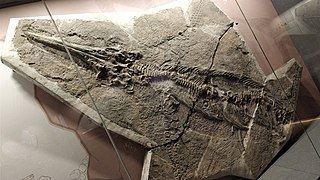
Guizhouichthyosaurus is an extinct genus of ichthyosaur which is known primarily from the Xiaowa Formation of the lower Carnian stage of the Late Triassic in southwest China. The type species of this genus is Guizhouichthyosaurus tangae, of which multiple skeletons are known. It has been reassigned as a species of the genus Shastasaurus in the past, though it has since been considered distinct. The ichthyosaurs Cymbospondylus asiaticus, named in 2002, and Panjiangsaurus epicharis, named in 2003, are junior synonyms of G. tangae. The genus is also known from the Ladinian-aged Middle Triassic Zhuganpo Formation; additionally, the species "Callawayia" wollongangense may belong to Guizhouichthyosaurus.

Sinosaurosphargis is an extinct genus of basal marine saurosphargid reptile known from the Middle Triassic Guanling Formation of Yunnan and Guizhou Provinces, southwestern China. It contains a single species, Sinosaurosphargis yunguiensis.
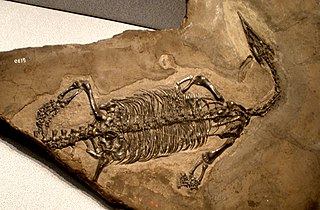
Askeptosauroidea is a superfamily of thalattosaurs, a Triassic group of marine reptiles. Askeptosauroidea is one of two major subgroups of Thalattosauria, the other being Thalattosauroidea. It includes the family Askeptosauridae and a more basal form called Endennasaurus.

Askeptosauridae is a family of thalattosaurs within the superfamily Askeptosauroidea. Fossils have been found from Italy, Switzerland, and China. Askeptosaurids are distinguished from other thalattosaurs by their long necks and narrow skulls.

Anshunsaurus is a genus of thalattosaurs within the family Askeptosauridae. Fossils have been found from Middle Triassic deposits in Guizhou, China. Three species are known: the type species A. huangguoshuensis, the slightly older species A. wushaensis, and the species A. huangnihensis.

Wumengosaurus is an extinct aquatic reptile from the Middle Triassic Guanling Formation of Guizhou, southwestern China. It was originally described as a basal eosauropterygian and usually is recovered as such by phylogenetic analyses, although one phylogeny has placed it as the sister taxon to Ichthyosauromorpha while refraining from a formal re-positioning.

Protorosauria is an extinct polyphyletic group of archosauromorph reptiles from the latest Middle Permian to the end of the Late Triassic of Asia, Europe and North America. It was named by the English anatomist and paleontologist Thomas Henry Huxley in 1871 as an order, originally to solely contain Protorosaurus. Other names which were once considered equivalent to Protorosauria include Prolacertiformes and Prolacertilia.
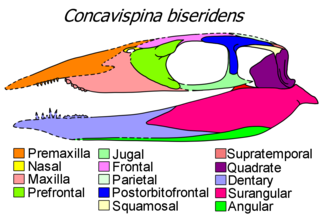
Concavispina is an extinct genus of thalattosaur reptile from the early Late Triassic Xiaowa Formation of Guangling, Guizhou, southern China. It contains a single species, Concavispina biseridens. It is known only from the holotype ZMNH M8804, a nearly complete 364 cm long skeleton. Concavispina can be differentiated from other thalattosaurs by possessing two rows of blunt teeth on the anterior part of the maxilla and a V-shaped notch on the dorsal margin of each neural spine in the dorsal (back) vertebrae. Both its generic and specific names refer to these autapomorphies, as Concavispina means "concave spine" and biseridens means "two rows of teeth". It is thought to be most closely related to Xinpusaurus, as both taxa share three derived characters: a maxilla that is curved upward at its anterior end, a humerus that is wider near the shoulder than near the elbow, and the presence of less than five cervicals.
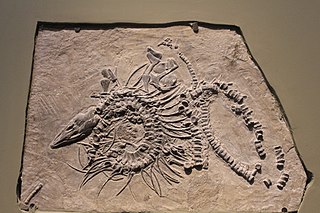
Xinpusaurus is an extinct genus of thalattosaur from the Late Triassic of Guanling in Guizhou, China. Several species have been named since 2000: the type species X. suni along with the species X. bamaolinensis and X. kohi. A 2013 study proposed that all three species are synonymous with each other, in which case X. suni would be the only valid species, although a 2014 study argued that X. kohi was also valid. A fourth species, X. xingyiensis, was described in 2016.

Blezingeria is an extinct genus of marine reptile from the Middle Triassic of Germany. The type and only species Blezingeria ichthyospondyla was named by German paleontologist Eberhard Fraas in 1896. It is known from many isolated bones that come from a deposit in southwestern Germany called the Upper Muschelkalk, which dates back to the Ladinian stage. The relationships of Blezingeria are uncertain. Fraas identified it as a nothosaur, but it has also been classified as a cymbospondylid ichthyosaur, and most recently a thalattosaur. Many thalattosaur fossils have been found in a slightly olderLate Ladinian-age rock unit in Monte San Giorgio, Switzerland, so if Blezingeria is a thalattosaur, it may represent an early stage in an evolutionary radiation of the group across the Tethys, an ocean that covered much of what is now Europe and southern China during the Triassic. However, since Blezingeria is known from very incomplete material, its classification as a thalattosaur remains uncertain.
Eohupehsuchus is a genus of extinct aquatic diapsid from the Upper Spathian of Hubei Province, located in Central China. The genus is monotypic and belongs to the order Hupehsuchia, whose members are characterized by toothless beak-like snouts, a row of dermal plates along their backs, and aquatic adaptations including paddle-shaped limbs and fusiform bodies with pachyostotic ribs.

Saurosphargidae is an extinct family of marine reptiles known from the early Middle Triassic of Europe and China.
The Xiaowa Formation is a Carnian-age geological formation found in southern China. It is a sequence of limestone and marls from the Carnian stage of the Triassic. Its lower section was previously known as the Wayao Formation or Wayao Member of the Falang Formation. In 2002, the Wayao Member was renamed and raised to the Xiaowa Formation to prevent confusion with an Eocene unit of the same name. Crinoids and marine reptiles are abundant in the Xiaowa Formation, forming a lagerstätte known as the Guanling biota. Ammonoids and conodonts found in the formation constrain its age to the early Carnian. Reptiles of the Guanling biota include ichthyosaurs, thalattosaurs, placodonts, and Odontochelys. Sedimentary events within this formation have been tied to the Carnian Pluvial Event.


























